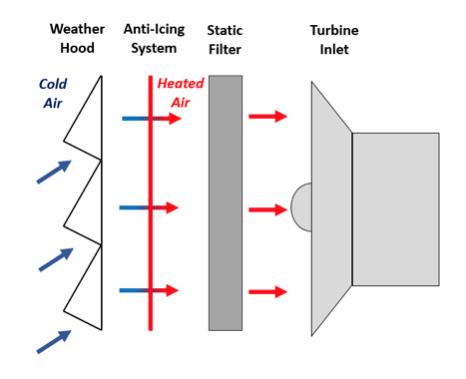Winter is here for most parts of the U.S. and for gas turbine operators, that means it is time to make sure that your anti-icing system is heating well at the correct times. The purpose of an anti-icing system is to prevent ice from forming on inlet air components. Ice build-up from a poorly performing anti-icing system may lead to turbine component damage, performance loss, ingestion of unfiltered air and damage to filter housings and ductwork. In this article, we’ll go through a few of the performance criteria that should be checked to ensure proper functioning an anti-icing system.
Anti-Icing System Location
We have seen some applications of Anti-Icing Systems installed downstream of the static filters. However, the optimal location for an anti-icing system is before the static filters to prevent ice from plugging the filters and causing excessive or damaging pressure drop.

Ambient Air Conditions
Anti-icing systems should be operating when ambient air conditions have a temperature range of between 40 degrees F (4.44 degrees C) and 20 degrees F (-6.67 degrees C). The upper end is set at 40 degrees F to protect from water potentially freezing at the low pressure of the air as it enters the inlet cone. The lower end is set at a point where even at 100% RH, the amount of water in the air is not a concern.
Mixed Air Conditions
An anti-icing system should be designed to add enough heat to the ambient air stream to yield a 25 degree F temperature increase at the extreme condition. However, the most critical part of adding heat to the ambient air stream is to ensure the heat is distributed evenly before it reaches the static filters.
Heat Source
If your anti-icing system is functioning properly, the last thing to consider is the heat source. Using compressor bleed, exhaust gas or recirculated glycol-water to provide heat can have drawbacks such as performance loss, leaking, corrosion and additional ductwork. A low maintenance and cost-effective alternative is to use high efficiency electric coils to heat a portion of the intake air that is then mixed with the remaining intake air. Temperature and ice sensors can be used to constantly adjust the electric coil output to closely regulate the amount of heat that is added to the intake air.
Getting it Right
We are experts in analyzing and fixing mass flow and air mixing problems. If your anti-icing systems is not doing what it should, let Eldridge help you get it right!
